Advancements in cold climate heat pump efficiency.
- Thread starter Brian26
- Start date
-
Active since 1995, Hearth.com is THE place on the internet for free information and advice about wood stoves, pellet stoves and other energy saving equipment.
We strive to provide opinions, articles, discussions and history related to Hearth Products and in a more general sense, energy issues.
We promote the EFFICIENT, RESPONSIBLE, CLEAN and SAFE use of all fuels, whether renewable or fossil.
You are using an out of date browser. It may not display this or other websites correctly.
You should upgrade or use an alternative browser.
You should upgrade or use an alternative browser.
Highbeam
Minister of Fire
Komrade
Member
Does anybody know if there is a list of high efficiency water heating appliances that are sold in US?
I've looked at Sanden, but it's low BTU (15k) is insufficient for heating.
I've briefly looked at Chiltrix, does not seem to have very good reputation.
Looks like there is LG Monobloc, but it don't appear to be avail in US based on what I can find. I am sure there are others from big name manufacturers.
I've looked at Sanden, but it's low BTU (15k) is insufficient for heating.
I've briefly looked at Chiltrix, does not seem to have very good reputation.
Looks like there is LG Monobloc, but it don't appear to be avail in US based on what I can find. I am sure there are others from big name manufacturers.
Last edited:
sloeffle
Minister of Fire
Does anybody know if there is a list of high efficiency water heating appliances that are sold in US?
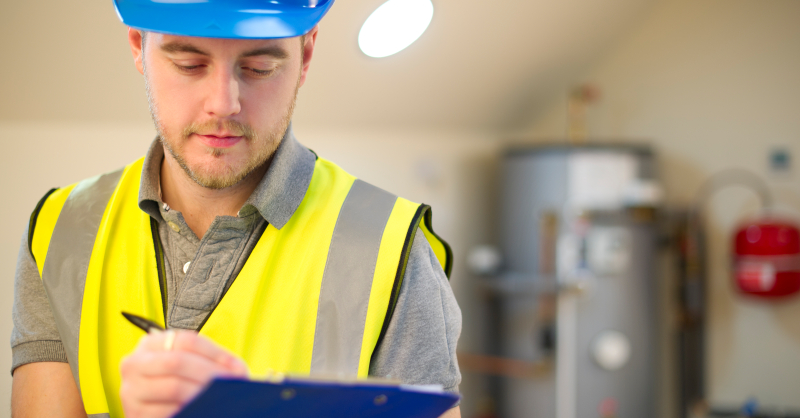
Product Finder — ENERGY STAR Certified Water Heaters
Compare ENERGY STAR Certified Water Heaters, find rebates, and learn more.
Highbeam
Minister of Fire

Product Finder — ENERGY STAR Certified Water Heaters
Compare ENERGY STAR Certified Water Heaters, find rebates, and learn more.www.energystar.gov
I think he means space heating, not domestic water heaters.
I wish the market would catch up on space heating heat pump water heaters. We know the tech is there but just not readily available in North America.
I agree. Almost all the air to water heat pumps are self contained outdoor units that require just running the water lines to the outdoor units. No refrigerant lines, vacuum or pressure testing is required. It seems like they would be easy to install since the refrigerant system is factory sealed.I think he means space heating, not domestic water heaters.
I wish the market would catch up on space heating heat pump water heaters. We know the tech is there but just not readily available in North America.
Efficiency Vermont is giving out a $1k per ton rebate for these units now. The issue appears most units can only produce 110 degree water at 5 degrees according to the VT list. The COP's seem to be around 2 at 5 degrees.
I think once they can get units to put out close to the 180 degree water temps that most fossil fuels hydronic units can easily obtain these will become more popular.
Air-to-Water Heat Pumps | Efficiency Vermont
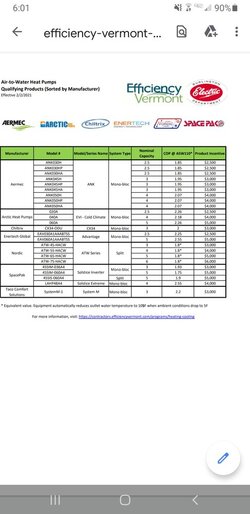
sloeffle
Minister of Fire
Ahhhhh yeah, you are right based off of the list he had.I think he means space heating, not domestic water heaters.
I wish the market would catch up on space heating heat pump water heaters. We know the tech is there but just not readily available in North America.
Looks like Mitsubishi upgraded their hyper heat models with a new deluxe model called H2i Plus. It has a significant jump in cold weather cop's and capacity. They are now rated to 100% heating capacity at -5.
I believe the prior version had 100 capacity to 5 degrees with a cop of less than 2 so quite an improvement.
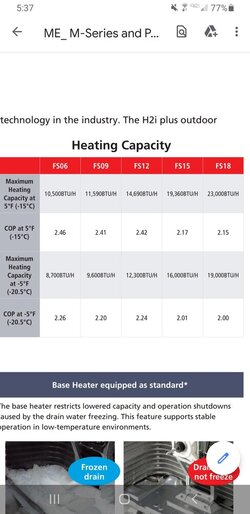
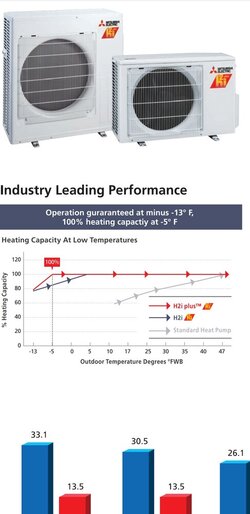
I believe the prior version had 100 capacity to 5 degrees with a cop of less than 2 so quite an improvement.


Last edited:
EbS-P
Minister of Fire
COP of 2 at -5F…. Impressive but not a large increase. So you figure your ideal load and order a 1/2 ton larger and I thing these would work many many people. I want to see output at -30 if I lived where it got really cold. I don’t care about the COP at that temp.Looks like Mitsubishi upgraded their hyper heat models with a new deluxe model called H2i Plus. It has a significant jump in cold weather cop's and capacity. They are now rated to 100% heating capacity at -5.
I believe the prior version had 100 capacity to 5 degrees with a cop of less than 2 so quite an improvement.
View attachment 283005 View attachment 283006
Evan
Hvac design temps below
stoveliker
Minister of Fire
EbS-P
Minister of Fire
500-1000 sq ft per ton….. no they are not for big spaces. But a single mini splits is not really not for whole house heat. And I don’t like the idea of heat pump as the only heat source. If a mini split could handle even 50-75% of the heating load that a great reduction in fossil fuel consumption.Though, 10-20000 BTU per HR may not cut it at -5 F...
maple1
Minister of Fire
Yessir. It is rather amazing how much of whatever other fuel you use, that a heat pump will reduce by using it just in shoulder seasons. My old wood oil boiler used a tank of oil and maybe 8 cords of wood a year. Switching to the gasifying boiler and storage got that down to maybe just 5 cords of wood with no oil. Added 2 heat pumps and I think I am down to 3 cords of wood. Plus now have really cheap a/c and dehumidifying.500-1000 sq ft per ton….. no they are not for big spaces. But a single mini splits is not really not for whole house heat. And I don’t like the idea of heat pump as the only heat source. If a mini split could handle even 50-75% of the heating load that a great reduction in fossil fuel consumption.
Their product line is a bit confusing for ducted systems pairing. It doesn't look like the H2i version is available in a 4 ton ducted version.
peakbagger
Minister of Fire
Hard to beat shoulder season use. On a clear night it will cool down quite a bit and stay cool until the sun is up for an hour or two. I run mine when I get up and once the sun starts coming in I turn it off. Once I have 24/7 heating demand I will start running the wood boiler but still will use the mini split on sunny days.
maple1
Minister of Fire
We liked ours so much we got another one put in last weekend, at our cottage. Another Daikin. We're there right now for our first Thanksgiving weekend away from home. Rest of the family coming tomorrow. Still made a fire on in the stove when we got here, as much for ambiance as anything else but nice to have the cheap easy heat source. Especially getting up in the morning.
EbS-P
Minister of Fire
Try to get a southern HVAC tech to look into that when you argue that you want the system size for heating not cooling. I just told them the model numbers to quote.Their product line is a bit confusing for ducted systems pairing. It doesn't look like the H2i version is available in a 4 ton ducted version.
It also looks like they really improved the capacity range on the new Mitsubishi as well. The 6 and 9k units can turn down to some really low numbers and just sip electricity. At 47 degrees at minimum speed the inverter is only using 110 watts to deliver 1600 btu/h. With such a low output it would be really hard to oversize one of these. Its also interesting that it can deliver twice its rated capacity at 47 degrees. It's low speed cooling is pretty impressive as well using only 90 watts for a cop of 6.13.
It seems Mitsubishi is using the full heat output at -5 to rate the capacity on these.
The chart is for the 9k.
 ashp.neep.org
ashp.neep.org
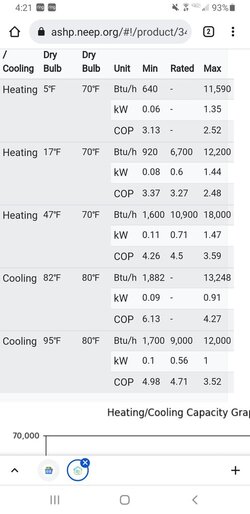
It seems Mitsubishi is using the full heat output at -5 to rate the capacity on these.
The chart is for the 9k.
ASHP

Last edited:
EbS-P
Minister of Fire
So here is the data for my trane 16xl 3 ton package unit manufactured in 2009.
COP17 is 2.55.
Yes it’s lost 33% capacity.
it seems all the efficiency gains are being spent on increasing capacity at low temps with these new units. Which is a good thing. I’d like to have that extra ton I’ve lost when it gets cold.
COP17 is 2.55.
Yes it’s lost 33% capacity.
it seems all the efficiency gains are being spent on increasing capacity at low temps with these new units. Which is a good thing. I’d like to have that extra ton I’ve lost when it gets cold.
Wiess
Member
Did you add a second head to an existing outside unit or additional outside unit too? The local Daikin dealers are suggesting the multi-head units and the Fujitsu dealer is suggesting two separate units, one per floor, and are a higher price. The federal grant is nice too!We liked ours so much we got another one put in last weekend, at our cottage. Another Daikin. We're there right now for our first Thanksgiving weekend away from home. Rest of the family coming tomorrow. Still made a fire on in the stove when we got here, as much for ambiance as anything else but nice to have the cheap easy heat source. Especially getting up in the morning.
maple1
Minister of Fire
All individual separate units. Our Daikin guy highly recommended doing it that way. I couldn't understand exactly why at the time, but I think he was right.Did you add a second head to an existing outside unit or additional outside unit too? The local Daikin dealers are suggesting the multi-head units and the Fujitsu dealer is suggesting two separate units, one per floor, and are a higher price. The federal grant is nice too!
Sounds like your installer knew what he was doing. Single 1 to 1 splits have superior efficiencies and turn down ratios to multi splits with more than one head on the same condensers. The outdoor units on multi splits have really high minimum capacities and they are still pumping refrigerant through heads even if they aren't on. A single 1 to 1 12k unit can turn down to a few hundred btu/h while a large 24k btu multisplit can only turn down to often 6k or more btu/h. I read that Maine did a study and found most of them were installed incorrectly and way oversized and their efficiencies Their were terrible. The state heat pump incentive is now longer offering a good incentive for them and it only applies to single 1 to 1 splits.All individual separate units. Our Daikin guy highly recommended doing it that way. I couldn't understand exactly why at the time, but I think he was right.
Wiess
Member
It sounds like I need revised quotes from the Daikin folks for separate units. They initially quoted the MXL Aurora Series with two indoor heads with one outdoor unit, plus an optional third head for the master bedroom. One indoor unit per floor, located at opposite ends of the house due to the layout. The individual components are listed on the NEEP site but not the complete system. They also proposed to run lines in my attic which is not my preference since we recently topped up the insulation to R50.
The Fujitsu proposal includes two separate units, a single indoor head connected to one outdoor unit. The outdoor units also installed at opposite ends of the house. Data from the NEEP site is included below.
In terms of quality - how do you rate Daikin and Fujitsu? Mitsubishi?
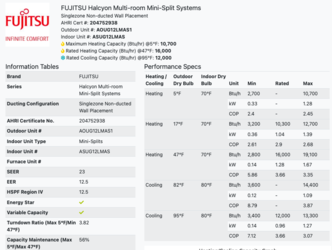
The Fujitsu proposal includes two separate units, a single indoor head connected to one outdoor unit. The outdoor units also installed at opposite ends of the house. Data from the NEEP site is included below.
In terms of quality - how do you rate Daikin and Fujitsu? Mitsubishi?

maple1
Minister of Fire
Sounds like using only 1 outside unit is leading to running more line sets where you might not want them to go. Another reason to go individual pairs. A lot easier to run a 240v wire source, than a line set. I dont think I would want any part of any heating system going through my attic.
IMO Daikin, Mitsu & Fujitsu are the big 3. Have not kept up lately but Mitsu might have recently pulled ahead a little bit, efficiency wise? Also, scrutinize warranty details. And what they cover and for how long. Notably, labour.
IMO Daikin, Mitsu & Fujitsu are the big 3. Have not kept up lately but Mitsu might have recently pulled ahead a little bit, efficiency wise? Also, scrutinize warranty details. And what they cover and for how long. Notably, labour.
EbS-P
Minister of Fire
It’s pretty standard practice for slab on grade construction. I agree if I I had a choice I would avoid it. And I would want to avoid condensation pumps. But sometimes it’s not possibleI dont think I would want any part of any heating system going through my attic.
maple1
Minister of Fire
Sounds like your installer knew what he was doing. Single 1 to 1 splits have superior efficiencies and turn down ratios to multi splits with more than one head on the same condensers. The outdoor units on multi splits have really high minimum capacities and they are still pumping refrigerant through heads even if they aren't on. A single 1 to 1 12k unit can turn down to a few hundred btu/h while a large 24k btu multisplit can only turn down to often 6k or more btu/h. I read that Maine did a study and found most of them were installed incorrectly and way oversized and their efficiencies Their were terrible. The state heat pump incentive is now longer offering a good incentive for them and it only applies to single 1 to 1 splits.
Yes, he is pretty good. He has been putting Daikins in for quite a while now, and told me they have been working out really well since day 1 with far far fewer call backs than he was anticipating there might be.
Similar threads
- Replies
- 51
- Views
- 5K
- Replies
- 7
- Views
- 1K
- Replies
- 2
- Views
- 2K
- Replies
- 0
- Views
- 927

